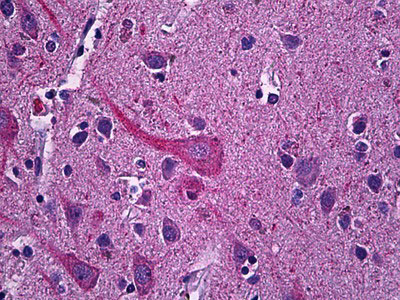SYT1 / Synaptotagmin Antibody (Internal)
Goat Polyclonal Antibody
- SPECIFICATION
- CITATIONS
- PROTOCOLS
- BACKGROUND

Application
| WB, IHC-P, E |
|---|---|
| Primary Accession | P21579 |
| Reactivity | Human, Mouse, Rat, Rabbit, Zebrafish, Hamster, Monkey, Pig, Chicken, Horse, Bovine, Dog |
| Host | Goat |
| Clonality | Polyclonal |
| Calculated MW | 48kDa |
| Dilution | ELISA (1:2000), IHC-P (3.75 µg/ml), WB (0.3-1 µg/ml) |
| Gene ID | 6857 |
|---|---|
| Other Names | Synaptotagmin-1, Synaptotagmin I, SytI, p65, SYT1, SVP65, SYT |
| Target/Specificity | Human SYT1 / Synaptotagmin. Reported isoforms NP_005630.1, NP_001129277.1 and NP_001129278.1 represent identical protein. |
| Reconstitution & Storage | Store at -20°C. Minimize freezing and thawing. |
| Precautions | SYT1 / Synaptotagmin Antibody (Internal) is for research use only and not for use in diagnostic or therapeutic procedures. |
| Name | SYT1 (HGNC:11509) |
|---|---|
| Synonyms | SVP65, SYT |
| Function | Calcium sensor that participates in triggering neurotransmitter release at the synapse (By similarity). May have a regulatory role in the membrane interactions during trafficking of synaptic vesicles at the active zone of the synapse (By similarity). It binds acidic phospholipids with a specificity that requires the presence of both an acidic head group and a diacyl backbone. A Ca(2+)- dependent interaction between synaptotagmin and putative receptors for activated protein kinase C has also been reported. It can bind to at least three additional proteins in a Ca(2+)-independent manner; these are neurexins, syntaxin and AP2. Plays a role in dendrite formation by melanocytes (PubMed:23999003). |
| Cellular Location | Cytoplasmic vesicle, secretory vesicle membrane {ECO:0000250|UniProtKB:P21707}; Single-pass membrane protein. Cytoplasmic vesicle, secretory vesicle, synaptic vesicle membrane {ECO:0000250|UniProtKB:P21707}; Single-pass membrane protein {ECO:0000250|UniProtKB:P21707}. Cytoplasmic vesicle, secretory vesicle, chromaffin granule membrane {ECO:0000250|UniProtKB:P21707}; Single-pass membrane protein {ECO:0000250|UniProtKB:P21707}. Cytoplasm {ECO:0000250|UniProtKB:P21707} |
| Tissue Location | Expressed in melanocytes (PubMed:23999003). |

Thousands of laboratories across the world have published research that depended on the performance of antibodies from Abcepta to advance their research. Check out links to articles that cite our products in major peer-reviewed journals, organized by research category.
info@abcepta.com, and receive a free "I Love Antibodies" mug.
Provided below are standard protocols that you may find useful for product applications.
Background
May have a regulatory role in the membrane interactions during trafficking of synaptic vesicles at the active zone of the synapse. It binds acidic phospholipids with a specificity that requires the presence of both an acidic head group and a diacyl backbone. A Ca(2+)-dependent interaction between synaptotagmin and putative receptors for activated protein kinase C has also been reported. It can bind to at least three additional proteins in a Ca(2+)-independent manner; these are neurexins, syntaxin and AP2.
References
Perin M.S.,et al.J. Biol. Chem. 266:615-622(1991).
Ota T.,et al.Nat. Genet. 36:40-45(2004).
Bechtel S.,et al.BMC Genomics 8:399-399(2007).
Mural R.J.,et al.Submitted (JUL-2005) to the EMBL/GenBank/DDBJ databases.
Han C.,et al.J. Immunol. 182:2986-2996(2009).
If you have used an Abcepta product and would like to share how it has performed, please click on the "Submit Review" button and provide the requested information. Our staff will examine and post your review and contact you if needed.
If you have any additional inquiries please email technical services at tech@abcepta.com.













 Foundational characteristics of cancer include proliferation, angiogenesis, migration, evasion of apoptosis, and cellular immortality. Find key markers for these cellular processes and antibodies to detect them.
Foundational characteristics of cancer include proliferation, angiogenesis, migration, evasion of apoptosis, and cellular immortality. Find key markers for these cellular processes and antibodies to detect them. The SUMOplot™ Analysis Program predicts and scores sumoylation sites in your protein. SUMOylation is a post-translational modification involved in various cellular processes, such as nuclear-cytosolic transport, transcriptional regulation, apoptosis, protein stability, response to stress, and progression through the cell cycle.
The SUMOplot™ Analysis Program predicts and scores sumoylation sites in your protein. SUMOylation is a post-translational modification involved in various cellular processes, such as nuclear-cytosolic transport, transcriptional regulation, apoptosis, protein stability, response to stress, and progression through the cell cycle. The Autophagy Receptor Motif Plotter predicts and scores autophagy receptor binding sites in your protein. Identifying proteins connected to this pathway is critical to understanding the role of autophagy in physiological as well as pathological processes such as development, differentiation, neurodegenerative diseases, stress, infection, and cancer.
The Autophagy Receptor Motif Plotter predicts and scores autophagy receptor binding sites in your protein. Identifying proteins connected to this pathway is critical to understanding the role of autophagy in physiological as well as pathological processes such as development, differentiation, neurodegenerative diseases, stress, infection, and cancer.



